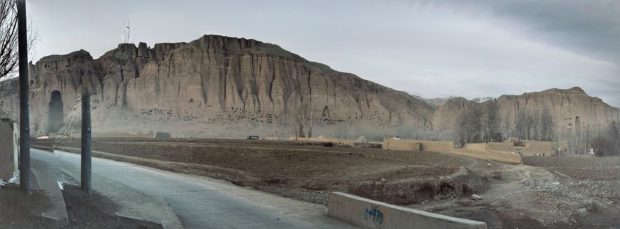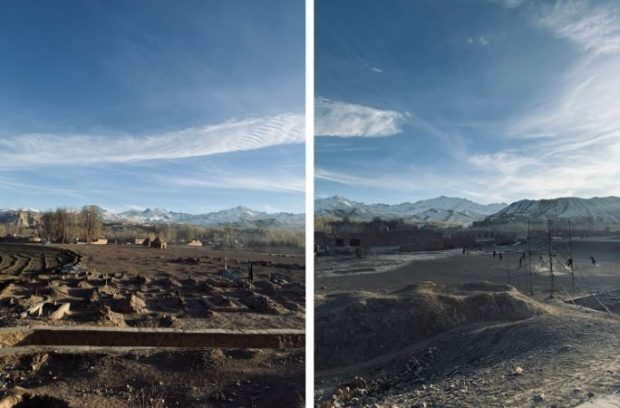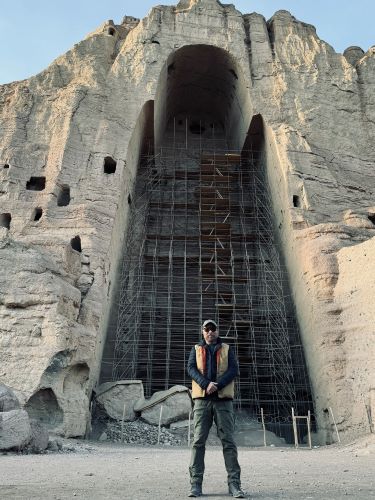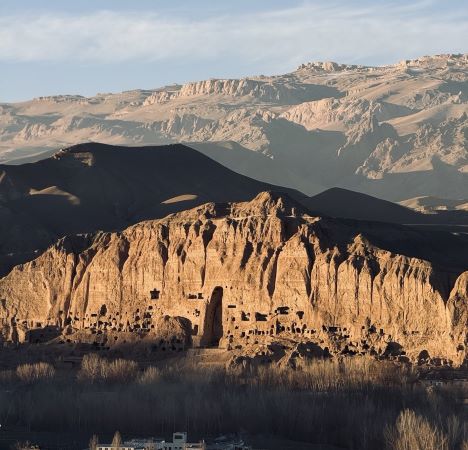The Two Faces of Taliban: Bamiyan Stone Buddhas reflect Taliban’s contradictions

Bamiyan Stone Buddhas and surrounding villages taken from a high mountain on the other side
Editor’s Note: The Taliban, an Islamic extremist armed group, has ruled Afghanistan twice (1996-2001 and 2021-present).
The Taliban’s first term in power in Afghanistan was marred by tyranny that suppressed all freedoms. The Taliban, who started their second term in power in 2021, say they are different from the way they were before, but the West’s gaze towards them is not much different from the past.
Which is the real face of the Taliban: what the Taliban says they are or what the West says about them? In December 2023, Lee Shin-seok, a reporter specializing in conflict areas for AsiaN, who dealt with Afghanistan under the Taliban with his body and mind, tells the story of the Taliban and Afghanistan as they are.
SEOUL: According to the biography of Wang ocheonchukguk jeon, written by Hyecho, a Silla monk, after exploring the five heavenly kingdoms of ancient India, the Bamiyan Stone Buddha, an ancient Buddhist relic in Bamiyan City, Afghanistan, is centered around a 56m high stone Buddha in the west and a 38m high stone Buddha in the east.
Built during the Kushan Dynasty in the 6th century, this ruin is well known as one of the largest stone Buddhas in the world. It is also listed as a UNESCO World Heritage Site.

To enter Bamyan Province and Bamyan City, anyone must pass through the gate at the back. Residents must submit a residence certificate and a permit for business vehicles such as taxis, and foreigners must submit a required questionnaire in addition to their passport and visa. However, the process was easier than checkpoints in other areas of Afghanistan, and it felt like a consideration for tourists who come to see the Bamiyan Stone Buddhas.
The Bamiyan Stone Buddhas are located on the Silk Road, but the road to reach them is not easy as it is surrounded by mountains. After crossing the mountain and reaching the area near the Bamiyan Stone Buddhas, the plain and the river flowing nearby come into view.
It is said that in the past, caravans traveling the Silk Road had plenty of water, food, and rest in villages built around the Bamiyan Gorge. There is a theory that Buddhism became established here as these merchants-built tabernacles throughout Bamiyan and enshrined stone statues of Buddha.
As a result, numerous monks who followed the Silk Road from China and India dug caves in Bamiyan and devoted themselves to salvation.

Bamiyan Stone Buddhas captured in panorama. Even though it was filmed in panoramic mode, it was not possible to capture the entire appearance of the Large Stone Buddha and the Small Stone Buddha. On the paved road in front of the stone Buddha, large trucks came and went, blowing up dust as construction work was going on somewhere.
Although I visited them and took pictures over the course of three days, the Bamiyan Stone Buddhas were so magnificent that I could not dare to capture them with the naked eye or even with a photo or camera. It was more than I imagined.
The distance from the large stone Buddha of the Bamiyan Stone Buddha to the small stone Buddha is known to be approximately one kilometer.
Several various sources said that there were about 100 caves, but in fact, there were many more caves and stupas hidden here and there. I went into several of them in person. Inside, traces of murals with religious colors remained here and there. Isn’t this what we are talking about: beauty that transcends time and religion?

Entrance to the sanctuary next to the small stone fire
In the Bamiyan Stone Buddhas, there were also caves engraved with Iran’s ancient Zoroastrian cross patterns. There is a theory that Zoroastrianism had a significant influence on the formation and spread of Buddhism, and traces of Zoroastrianism remained in the largest stone Buddha of ancient Buddhism.
It may be surprising that Afghanistan, where Islam is the state religion, has the Bamiyan Stone Buddhas, one of the largest Buddhist relics in the world. However, Buddhist culture spread throughout Afghanistan, including the city of Bamiyan.
The birthplace of Buddha, the founder of Buddhism, is Lumbini, Nepal, and it is a common belief that Buddhism was formed around the ancient kingdom of Magadha between northeastern India and Nepal in the 6th to 5th centuries BC.
However, Aurel Stein (1862-1943), a Hungarian-British archaeologist who died in Kabul, the capital of Afghanistan, had slightly different opinions.
After exploring Buddhist ruins throughout Central Asia over a long period of time, he claimed that the origin of Buddhism was the Sistan (Zabulistan) region, which extends to present-day southeastern Iran and southwestern Afghanistan.
The existence of the Bamiyan Stone Buddha and the prevalence of Buddhism centered on the city of Bamiyan support his argument. We cannot overlook the fact that no traces of ancient Buddhism can be found in India. Therefore, to this day, this topic is causing controversy in the Buddhist world, but the argument of Aurel Stein’s group is one of several hypotheses.

Widely spread farmland in front of the Bamian Stone Buddha (left) and the vacant lot in front of the Great Stone Buddha. Residents of nearby villages are farming or enjoying soccer in a corner of the vacant lot – part of daily life here.
The modern history of the Bamiyan Grottoes, which were the center of Buddhism on the Silk Road, has had many ups and downs.
In the 1960s and 1970s, the Bamiyan Grottoes were full of Western hippies, who lived in the caves and damaged the interior and exterior of the space. In the 1980s, when the Soviet Union invaded Afghanistan, Soviet soldiers destroyed part of the Bamiyan Caves.
In the mid-1990s, the Taliban took control of Afghanistan, and the fate of the Bamiyan Caves became tragic. Mullah Omar, the founder of the Taliban, viewed the West’s behavior as duplicitous. It was dissatisfying to see Western countries saying they were helping Afghanistan, but restoring and supporting the Bamiyan Stone Buddhas, which were like a local landmark, rather than the suffering people or refugees.

The author in front of the Great Stone Buddha, currently under restoration construction.
Of the two branches of Islam, the Pashtuns, who follow the Sunni sect, were the majority in Afghanistan, while the Hazaras, who follow the Shia sect, were the minority and lived in the Bamiyan area. Omar thought that the presence of the Bamiyan Stone Buddhas, which were touched by the West, undermined Afghanistan’s ethnic homogeneity.
The Taliban, who are from the majority Pashtun ethnic group, began destroying the Bamiyan Caves using military weapons such as tanks and cannons in 1998. In 2001, they broadcast live around the world the blowing of the Bamiyan Caves with dynamite. That is why all kinds of scars remain in the existing Bamiyan Grottoes.

Sunset at Bamiyan Stone Buddhas
Ironically, Taliban, who returned to power in August 2021, is making money from the Bamiyan Stone Buddha, one of Afghanistan’s few tourist resources. The Taliban destroyed the Bamiyan Caves because they were tired of the West’s duplicity, but they actually used it because they needed it, revealing the contradiction.
When the Taliban retook control of Afghanistan for the first time in about 20 years, they declared that there would be no previous reign of terror.
However, the West still views the Taliban as oppressing Afghanistan’s freedom, women’s rights, and culture.
So, the question is: Which is the real face, the Taliban’s own account or the West’s version of the Taliban? As seen in the Bamiyan Stone Buddhas, isn’t the Taliban’s rule over Afghanistan different from the outside and the inside? This is why we chose the Bamiyan Stone Buddha, where the Taliban’s duplicity is reflected, as the starting point of this journey.

























































